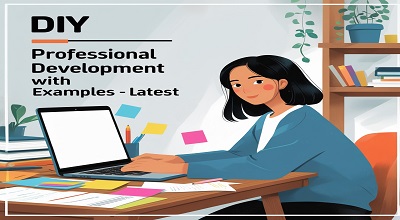DIY Professional Development
DIY Professional Development: In today’s fast-evolving educational landscape, teachers must continuously upgrade their skills to stay relevant. However, traditional professional development (PD) programs can be expensive, time-consuming, and sometimes ineffective. The solution? DIY (Do-It-Yourself) Professional Development—a flexible, cost-effective, and personalised approach to learning.
This comprehensive guide explores DIY professional developments, providing actionable strategies, real-world examples, and the latest trends to help educators take charge of their growth.
What is DIY Professional Development?
DIY Professional Development refers to self-directed learning where educators design their own growth plans instead of relying solely on school-mandated training. It includes:
- Online courses & webinars
- Reading books & research papers
- Joining professional learning networks (PLNs)
- Attending virtual conferences
- Engaging in peer collaborations
Why is DIY PD Gaining Popularity?
- Personalized Learning: Focus on individual needs.
- Flexibility: Learn at your own pace.
- Cost-Effective: Many free or low-cost resources available.
Benefits of DIY Professional Development
A. Customized Learning Path
Teachers can focus on areas they want to improve, such as:
- Classroom management
- EdTech integration
- Student engagement strategies
B. Continuous Improvement
Unlike one-time workshops, DIY PD allows for ongoing skill enhancement.
C. Networking Opportunities
Engaging in online communities (Twitter chats, LinkedIn groups) helps educators exchange ideas globally.
D. Cost Savings
Free webinars, MOOCs (Massive Open Online Courses), and open educational resources (OERs) reduce expenses.
How to Create a DIY Professional Development Plan?
1: Identify Your Goals
- What skills do you want to develop?
- What are your students’ needs?
2: Choose Your Learning Resources
- Online Courses: Coursera, edX, Khan Academy
- Podcasts: The Cult of Pedagogy, EdSurge Podcast
- Books: “Teach Like a Champion,” “The Growth Mindset Coach”
3: Implement & Reflect
- Apply new strategies in the classroom.
- Reflect on what works and adjust accordingly.
4: Share Your Learning
- Blog about your experiences.
- Present at staff meetings or local conferences.
Latest Trends in DIY Professional Development
A. Micro-Credentials & Digital Badges
Platforms like Digital Promise offer certifications for completing short courses.
B. AI-Powered Learning Assistants
Chatbots and AI tools (like ChatGPT) help educators find resources quickly.
C. Gamified PD
Apps like Kahoot! and Quizizz make learning interactive.
D. Social Media PD
Twitter chats (#EdChat, #TeacherPD) and Facebook groups foster collaboration.
Real-World Examples of DIY PD in Action
1: Flipped Professional Development
A teacher watches TED-Ed videos on differentiated instruction and applies techniques in class.
2: Peer-Led Book Study
A group of educators reads “Visible Learning” and meets weekly to discuss key takeaways.
3: Virtual Conference Participation
An educator attends ISTE Live and implements AI tools learned from sessions.
Tools and Resources for DIY Professional Development
| Resource | Description | Link |
|---|---|---|
| Coursera | Free courses from top universities | coursera.org |
| Edutopia | Research-backed teaching strategies | edutopia.org |
| Google for Education | Free PD courses on Google tools | edu.google.com |
Challenges and How to Overcome Them
1: Time Management
- Solution: Dedicate 30 minutes daily to PD.
2: Staying Motivated
- Solution: Join an accountability group.
3: Information Overload
- Solution: Focus on one topic at a time.
Conclusion
DIY Professional Development empowers educators to take control of their growth in a flexible, affordable way. By leveraging online resources, peer networks, and the latest trends, teachers can stay ahead in their profession.
Start your DIY PD journey today and transform your teaching!
FAQs
Q1: Is DIY PD recognized by schools?
Many schools accept micro-credentials and digital badges as valid PD.
Q2: How much time should I spend on DIY PD?
Even 1-2 hours per week can make a significant impact.
Q3: Are there free DIY PD options?
Yes! Platforms like Coursera, edX, and YouTube offer free courses.
